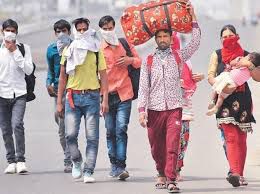Labour Laws, Health And Safety Of Workers In Factories, Industries, Etc.
The standards of labours is maintained according to Trade Union Act, Industrial
Dispute Act, Factories Act, Payment of Wages Act, etc. The condition Labours and
workmen have been marginalized to a greater extent as they lack knowledge of
basic law which were made for their own benefits. It is very essential for
workmen to get better working conditions for getting better output and for their
own health conditions.
There have been numerous instances and cases wherein it was found that due to poor health condition of factory, industry or workplace the workmen or worker of the factory had died or had suffered some serious injuries
The factory or workplace provide very poor safety and health condition and they are exposed to heavy and dangerous machinery which majorly affects the safety conditions of these workmen. The workers of factories and industry also deals with concentrated chemicals and hazardous substance which can lead to respiratory issues, nervous system breakdown, serious nausea conditions, dermatitis, poisoning, etc.
Section 11 Factories Act states that cleanliness of factory should be done regularly and daily. It shall be free from effluents and dirt which arise in the factory. Such shall be done by removing and preventing the accumulation of dirt in the factory by sweeping or other methods of cleaning which is effective in nature, the floors of workroom shall be cleaned atleast once a week by usage of water and disinfectants, sanitizers and other measures.
The moistness of the floor and rooms shall also be removed once the work in the factory is done. Section 12 Factories Act also states that the wastes and effluents produces during manufacturing process shall be removed and proper ventilation and temperature should be maintained with proper circulation of air and the temperature not being very high or low according to the Section 13 of the act
The factories Act also lays down the guidelines w.r.t drinking water facilities and latrines and urinals. Section 18 Factories Act states that there must be clean drinking water available to the workers which shall have adequate water supply. Both hot and cold water shall be made available. Between the water cooler or source, latrines and spittoons there shall be a 6 meters' distance
The Section 19 of Factories Act states that there shall be enough accessible latrines and urinals for the workers and male and female employees of a factory shall have a separate urinal and latrine system(s) being installed in the factory. Both the urinals and latrines shall be kept clean according to the safety standards.
It was exposed to more than 5,00,000 people including people residing in town and workers working in the unit. Death toll rose upto 3787 due to the gas release. Such an incident brought to attention safety of workers working in any industry, unit or factory
The Factories Act, 1948 provides provisions and guidelines for protection of workers working in the unit/ industry/ factory. Section 21-41 Factories Act provides guidelines for safety of workers
The Section 23 of the act prohibits young person or employees to work in dangerous machinery. Such person may only be allowed if and only if they have been fully instructed about the dangers that may occur while operating such dangerous machinery and all the necessary precautions have been taken up by the person who is employed in operation of the dangerous machinery.
Such a person shall also have:
In order to promote safety conditions of workers, all the floors, stairs and all the places which may be accessed by the workers or employees shall be constructed in a sound manner without any loophole. In case of stairways, it shall be equipped with handrails. There shall also not be any obstructions as provided by Section 32 Factories Act. In case any activity is of such nature wherein it involves exposure to eyes or any dangerous conditioning to the eyes of the workers, safety goggles shall be provided to the workers working in particular activity exposing eye of the person. There shall also not be exposure of the person to excessive lighting which may affect the eyes
Health and Safety standards of workers in factories (Statistics)
According to reports given by RTI and of Director General of Factory Advice Service and Labour Institutes (DGFASLI) as per 2020, 3 workers die every day in India while working in factories. In 2020, a whopping 363,442 deaths of factory workers was witnessed in India of which Gujarat topped the list with most deaths followed by Maharashtra. Between the period of 5 years i.e. 2018 to 2022, the National Capital of India i.e. Delhi witnessed 118 death of factory labours. Stats suggest that average 4000 workers die every year in factories between the period of 2017 to 2022 and nearly 1100 deaths occur every year
In 2021, it was witnessed that the workers employed in manufacturing industries were exposed to serious health and safety hazards in India. 162 workers died in 2021 in this sector and many were serious injured with non-fatal injuries. It can also be witnessed that nearly 115 million people have been registered under manufacturing sector but on 1/10 of them are being registered. Studies show women under factories often witness sexual harassment and children are made to work beyond 6 hours without provision of proper health facilities and safety equipment.
As per reports, the workers are made to work in poor conditions with minimal safety equipment's being provided to them. There are no or less lighting provided in the factories which is also a major contributing factor to the accidents and mishappenings in the factories. Proper training and safety equipment is not provided to workers and the employees in the industries for handling heavy and hazardous machinery which not only risks life through accidents but also increases the chances of workers being prone to deadly diseases and health issues. Crushed report 2022 also suggest that the workers are not provided safety equipment and gears which also led them lose their hands and fingers due to accident at large scale.
OSH CODE, 2020
The health and safety of employees became topic of paramount importance for the government and rule making bodies in India. For such issues, OSH code came into existence in correspondence of Factories Act, 1948. Occupational Safety, Health and Working Conditions Code, 2020 (OSH Code) was introduced in order to improve the health and safety facilities of workers in the factories. It was brought to improve the working conditions of workers employed in factories majorly. In such code health and safety rules for the employees were laid down along with certain guidelines to be followed by factory employers and employees. It also takes cares of the medical and sanitary facilities of workers and the employees being employed.
Section 8(1) of OSH Code states that every employer shall designs, manufacturing, imports, etc. shall reasonably take steps for health and safety of workers and shall ensure that all the articles, etc. are properly used taking care of safety before using such articles by the workers. Section 15 OSH Code provides guidelines that no employee should recklessly use, interfere, damage, misuse anything which could reasonably affect the health and safety standards of the worker(s) in the factory or establishment.
A board shall be assigned to keep a check on health and safety standards at workplace and shall inspect time to time ensuring health and safety standards at the workplace. Section 16(1) OSH Code states that Central Government shall appoint National Occupational Health and Safety Board who shall assist government in matters relating to health and safety of the employees. They may make policy and assist central government in making policy.
Chapter IX of the code specifically takes care of standards to ensure safety and health of women employed in the workplace. According to Section 43 OSH Code, the women employees shall not work before 6:00 AM and beyond 7:00 PM. There shall be a proper consent been taken from women in order to work beyond or before specified timings. According to Section 44 OSH Code, women shall not be forced to do any activity which may be hazardous for their health or affects their safety.
The act specifically provides guidelines measures, health and safety of workers or employees in any establishment. Section 80 of OSH Code specifies that any leased property of factory or establishment shall be equipped with proper facilities regarding health, safety, shall have proper ventilation facilities, fire prevention methods, emergency methods, canteens, toilets, shelters, rest rooms, etc. being provided for ensuring health and safety facilities of the people or employers in the premise. Appropriate Government shall prescribe relating to such facilities and should be responsible for the same
The Occupational Safety, Health and Working Conditions Code, 2020 (OSH Code) was established to improve the conditions of the employees and the workmen and is yet not being formalized but is under consideration. The OSH Code is made in contravention to Factories Act, 1948 which had certain loop holes with regard to health and safety of the workers and employees especially employed in the factories and such work places. It also provides specific measures to ensure safety and health of women in these workplaces.
Conclusion:
The health and safety of workers employed in factory units have become a need of the hour and it is the responsibility of the appropriate government to keep an eye on the employers that they are providing proper health facilities to the workers or not. Children under Article 24 of Constitution of India are prohibited to work under factories or similar workplaces which shall be ensured by the government of India.
Although, it can be witnessed that many steps and measures have been taken by the government and law making bodies to improve the condition of workers in the factories but the condition of workers have yet not been the way it should have been
Workers are working under very unhygienic and low sanitized conditions which is detrimental to their health and safety equipment is not provided before exposing them to heavy and hazardous machinery which has toppled the death rate and injury rate of the workers employed in the factory units. It is very harmful for them. Moreover, the many cases of crime against women can be witnessed in the factory at large which may even prevent them from working in the factories and establishment
The appropriate government and central government should ensure health and safety of workers employed in the factory by providing a proper check facility and keeping an eye on the activities of the employer of the factory and such establishment at large.
There have been numerous instances and cases wherein it was found that due to poor health condition of factory, industry or workplace the workmen or worker of the factory had died or had suffered some serious injuries
The factory or workplace provide very poor safety and health condition and they are exposed to heavy and dangerous machinery which majorly affects the safety conditions of these workmen. The workers of factories and industry also deals with concentrated chemicals and hazardous substance which can lead to respiratory issues, nervous system breakdown, serious nausea conditions, dermatitis, poisoning, etc.
How is health and condition of employees protected?
The health and safety conditions of employees and workmen are protected and guided through the Factories Act 1968. Section 11 to 20 Factories Act lays down guidelines to protect the health of workers of factories.Section 11 Factories Act states that cleanliness of factory should be done regularly and daily. It shall be free from effluents and dirt which arise in the factory. Such shall be done by removing and preventing the accumulation of dirt in the factory by sweeping or other methods of cleaning which is effective in nature, the floors of workroom shall be cleaned atleast once a week by usage of water and disinfectants, sanitizers and other measures.
The moistness of the floor and rooms shall also be removed once the work in the factory is done. Section 12 Factories Act also states that the wastes and effluents produces during manufacturing process shall be removed and proper ventilation and temperature should be maintained with proper circulation of air and the temperature not being very high or low according to the Section 13 of the act
The factories Act also lays down the guidelines w.r.t drinking water facilities and latrines and urinals. Section 18 Factories Act states that there must be clean drinking water available to the workers which shall have adequate water supply. Both hot and cold water shall be made available. Between the water cooler or source, latrines and spittoons there shall be a 6 meters' distance
The Section 19 of Factories Act states that there shall be enough accessible latrines and urinals for the workers and male and female employees of a factory shall have a separate urinal and latrine system(s) being installed in the factory. Both the urinals and latrines shall be kept clean according to the safety standards.
How is safety of workers maintained in factories
A safety of a worker in a factory shall be a prime importance in a factory unit. Unsafe working condition can lead to grievous injuries which can be at times fatal in nature. Workers are exposed to heavy machinery and dangerous chemicals which can lead to fatal results. Bhopal Gas Tragedy can be one such incident wherein Union Carbide India Limited a pesticide plant as due to negligence during night a very dangerous chemical Methyl Isocyanate was released which released toxic gas.It was exposed to more than 5,00,000 people including people residing in town and workers working in the unit. Death toll rose upto 3787 due to the gas release. Such an incident brought to attention safety of workers working in any industry, unit or factory
The Factories Act, 1948 provides provisions and guidelines for protection of workers working in the unit/ industry/ factory. Section 21-41 Factories Act provides guidelines for safety of workers
According to Section 21 Factories Act, Certain specific types of machinery shall be fenced such machinery include:
- Every moving part of a prime mover or every flywheel connected to moving part
- Headrace and Tailrace of a wind turbine and water-wheel
- any part of a stock-bar which projects beyond the head stock of a lathe
- If they shall be securely fenced for before usage, such include:
- Part of electric generator, motor or rotary converter
- Part of transmission machinery
- Any dangerous part of machinery
The Section 23 of the act prohibits young person or employees to work in dangerous machinery. Such person may only be allowed if and only if they have been fully instructed about the dangers that may occur while operating such dangerous machinery and all the necessary precautions have been taken up by the person who is employed in operation of the dangerous machinery.
Such a person shall also have:
- Been working under the supervision of any superior or any senior
- Received sufficient amount of training to operate to the particular
machine by any person who had sufficient amount of training and knowledge
about the machinery and has been experienced in operating the machinery
In order to promote safety conditions of workers, all the floors, stairs and all the places which may be accessed by the workers or employees shall be constructed in a sound manner without any loophole. In case of stairways, it shall be equipped with handrails. There shall also not be any obstructions as provided by Section 32 Factories Act. In case any activity is of such nature wherein it involves exposure to eyes or any dangerous conditioning to the eyes of the workers, safety goggles shall be provided to the workers working in particular activity exposing eye of the person. There shall also not be exposure of the person to excessive lighting which may affect the eyes
Health and Safety standards of workers in factories (Statistics)
According to reports given by RTI and of Director General of Factory Advice Service and Labour Institutes (DGFASLI) as per 2020, 3 workers die every day in India while working in factories. In 2020, a whopping 363,442 deaths of factory workers was witnessed in India of which Gujarat topped the list with most deaths followed by Maharashtra. Between the period of 5 years i.e. 2018 to 2022, the National Capital of India i.e. Delhi witnessed 118 death of factory labours. Stats suggest that average 4000 workers die every year in factories between the period of 2017 to 2022 and nearly 1100 deaths occur every year
In 2021, it was witnessed that the workers employed in manufacturing industries were exposed to serious health and safety hazards in India. 162 workers died in 2021 in this sector and many were serious injured with non-fatal injuries. It can also be witnessed that nearly 115 million people have been registered under manufacturing sector but on 1/10 of them are being registered. Studies show women under factories often witness sexual harassment and children are made to work beyond 6 hours without provision of proper health facilities and safety equipment.
As per reports, the workers are made to work in poor conditions with minimal safety equipment's being provided to them. There are no or less lighting provided in the factories which is also a major contributing factor to the accidents and mishappenings in the factories. Proper training and safety equipment is not provided to workers and the employees in the industries for handling heavy and hazardous machinery which not only risks life through accidents but also increases the chances of workers being prone to deadly diseases and health issues. Crushed report 2022 also suggest that the workers are not provided safety equipment and gears which also led them lose their hands and fingers due to accident at large scale.
OSH CODE, 2020
The health and safety of employees became topic of paramount importance for the government and rule making bodies in India. For such issues, OSH code came into existence in correspondence of Factories Act, 1948. Occupational Safety, Health and Working Conditions Code, 2020 (OSH Code) was introduced in order to improve the health and safety facilities of workers in the factories. It was brought to improve the working conditions of workers employed in factories majorly. In such code health and safety rules for the employees were laid down along with certain guidelines to be followed by factory employers and employees. It also takes cares of the medical and sanitary facilities of workers and the employees being employed.
Section 8(1) of OSH Code states that every employer shall designs, manufacturing, imports, etc. shall reasonably take steps for health and safety of workers and shall ensure that all the articles, etc. are properly used taking care of safety before using such articles by the workers. Section 15 OSH Code provides guidelines that no employee should recklessly use, interfere, damage, misuse anything which could reasonably affect the health and safety standards of the worker(s) in the factory or establishment.
A board shall be assigned to keep a check on health and safety standards at workplace and shall inspect time to time ensuring health and safety standards at the workplace. Section 16(1) OSH Code states that Central Government shall appoint National Occupational Health and Safety Board who shall assist government in matters relating to health and safety of the employees. They may make policy and assist central government in making policy.
Chapter IX of the code specifically takes care of standards to ensure safety and health of women employed in the workplace. According to Section 43 OSH Code, the women employees shall not work before 6:00 AM and beyond 7:00 PM. There shall be a proper consent been taken from women in order to work beyond or before specified timings. According to Section 44 OSH Code, women shall not be forced to do any activity which may be hazardous for their health or affects their safety.
The act specifically provides guidelines measures, health and safety of workers or employees in any establishment. Section 80 of OSH Code specifies that any leased property of factory or establishment shall be equipped with proper facilities regarding health, safety, shall have proper ventilation facilities, fire prevention methods, emergency methods, canteens, toilets, shelters, rest rooms, etc. being provided for ensuring health and safety facilities of the people or employers in the premise. Appropriate Government shall prescribe relating to such facilities and should be responsible for the same
The Occupational Safety, Health and Working Conditions Code, 2020 (OSH Code) was established to improve the conditions of the employees and the workmen and is yet not being formalized but is under consideration. The OSH Code is made in contravention to Factories Act, 1948 which had certain loop holes with regard to health and safety of the workers and employees especially employed in the factories and such work places. It also provides specific measures to ensure safety and health of women in these workplaces.
Conclusion:
The health and safety of workers employed in factory units have become a need of the hour and it is the responsibility of the appropriate government to keep an eye on the employers that they are providing proper health facilities to the workers or not. Children under Article 24 of Constitution of India are prohibited to work under factories or similar workplaces which shall be ensured by the government of India.
Although, it can be witnessed that many steps and measures have been taken by the government and law making bodies to improve the condition of workers in the factories but the condition of workers have yet not been the way it should have been
Workers are working under very unhygienic and low sanitized conditions which is detrimental to their health and safety equipment is not provided before exposing them to heavy and hazardous machinery which has toppled the death rate and injury rate of the workers employed in the factory units. It is very harmful for them. Moreover, the many cases of crime against women can be witnessed in the factory at large which may even prevent them from working in the factories and establishment
The appropriate government and central government should ensure health and safety of workers employed in the factory by providing a proper check facility and keeping an eye on the activities of the employer of the factory and such establishment at large.
Law Article in India
Legal Question & Answers
Lawyers in India - Search By City
LawArticles
How To File For Mutual Divorce In Delhi

How To File For Mutual Divorce In Delhi Mutual Consent Divorce is the Simplest Way to Obtain a D...
Increased Age For Girls Marriage

It is hoped that the Prohibition of Child Marriage (Amendment) Bill, 2021, which intends to inc...
Facade of Social Media

One may very easily get absorbed in the lives of others as one scrolls through a Facebook news ...
Section 482 CrPc - Quashing Of FIR: Guid...

The Inherent power under Section 482 in The Code Of Criminal Procedure, 1973 (37th Chapter of t...
The Uniform Civil Code (UCC) in India: A...

The Uniform Civil Code (UCC) is a concept that proposes the unification of personal laws across...
Role Of Artificial Intelligence In Legal...

Artificial intelligence (AI) is revolutionizing various sectors of the economy, and the legal i...








Please Drop Your Comments